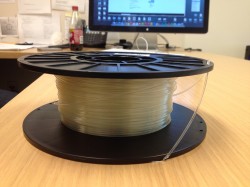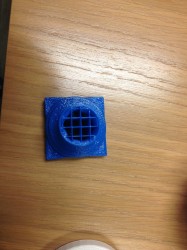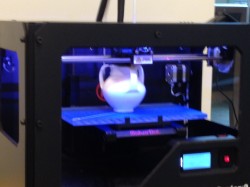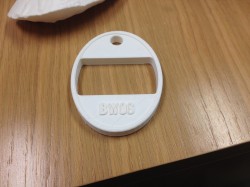When Bwog heard that Columbia now owns a 3-D printer, and that students can submit designs to be printed, we knew we had to learn more. So, we sent magnificent mage Julia Goodman on a quest to unearth the secrets of this spellbinding device.
It was a dark and stormy night day in the village of Morningside Heights when I made the dangerous trek from my cozy Hartley single up to the tower of doom that NoCo represents to all we who claim the tile of English major. Having recently discovered that there was actually something besides Joe’s Coffee in there, I braved the wind and rain to discover that, in fact, those science types have a pretty nice library. Arriving only slightly the worse for wear, I realized that the most difficult part of my journey still lay ahead. With no map, I was lost in an unfamiliar land, and for all I knew, a denizen of Words was the enemy here in territory that had been firmly claimed for Numbers.
Cautiously, I approached the Guardian of the Science and Engineering Library, and requested directions to the vast behemoth I assumed the mythical Three Dimensional Printer must be. Receiving naught but a silent, unearthly gesture towards the back of the room, I slowly crept away from the exit, and into the depths of the library. I approached the region of the King of the Three Dimensional Printer, and there it was—an unexpectedly diminutive device of enchanted scientifically-designed bits and pieces. “Come in,” beckoned a hushed voice. I slowly pushed open the great glass doors, and was privileged to be offered a chair by the King of the 3-D Printer himself. His name was Jeff.
After pulling out several things the printer has printed so far, Jeff explained how it works. Unlike a traditional 2-D printer, the 3-D variety prints plastic rather than ink. The plastic comes in spools of material in all different colors, which the printer melts down and extrudes to build a model from the bottom up. It works line by line, filling printed objects in with a grid formation that can have more or less empty space depending on how heavy the user wants the final object to be. At the upper end, it can print things that are completely solid. It can take up to several hours for larger and more intricate designs to print, and so far Jeff has been printing a few things a week depending on his schedule.
- The “printer paper”
- The material prints in layers from bottom to top
- The model is constructed on a ledge inside the printer
- The finished product!
We also talked about what the printer is used for. Some of the things that have been printed so far include models of people’s faces, a piece of a topography map, and shards of pottery that have been reconstructed from actual remains of ancient societies. When I visited Jeff’s office, the printer was almost done with a complete model of a pot that an archaeology student had constructed based on incomplete shards of the pot. The possibilities for the 3-D printer are pretty much endless, even more varied than those of a 2-D printer. Those uses can range from the academic to the purely entertaining, as evidenced by the Bwog-themed bottle opener I printed.
Since Columbia only got the printer at the end of last year, its potential uses are still being explored, but more and more are discovered every time a student submits something to be printed. Yes, you read that right: literally anyone with a Columbia/Barnard email address can submit things to be printed. Once you submit a design, if Jeff chooses it to be printed, he will send you an email letting you know your item is ready to be picked up. His decisions include factors such as how successfully the printer will be able to construct a model (the fewer spindly small parts the better), and whether or not it is an original design. For those of us—including myself, before this adventure—who are unfamiliar with how to construct a three-dimensional model, there are plenty of other resources on the site to take advantage of.
Building a computer model is much simpler than you might think, even if you aren’t an engineer or a designer, and even if you have only the vaguest idea of how computers work. On the homepage of the site there are links to free downloads of 3-D modeling software, and a site called 123D that lets you design models online without downloading anything. There is also a contest running right now; everyone who submits an original design will be entered to win some fancy tech prizes, including a device called a Raspberry Pi (no, it’s not food). As Jeff put it, “The more people submit designs, the more we can make.” So get out there, Bwog readers, and decide what the future of the 3-D printer will be!
How exactly does one come to be given the title of King of the 3-D Printer? Well, as it turns out, Jeff was the one to push for Columbia to bestow this device upon the Science and Engineering Library. It’s all part of a move towards making the library a collaborative, creative space, where people from all fields will be able to work together. It turns out humanities majors needn’t worry about venturing into an engineering-focused building—the Land of the 3-D Printer is, in fact, a neutral zone, where people of all backgrounds are equally welcome.


 3 Comments
3 Comments






3 Comments
@Anonymous by “when bwog heard,” do you mean watched the spec video on it?
http://www.columbiaspectator.com/multimedia/news/2013/11/06/3d-printing-lancaster
@Anonymous This a great thing for all students to have accesss to.
@john smith Someone should submit a liberator (Liberator: https://en.wikipedia.org/wiki/Liberator_(gun))